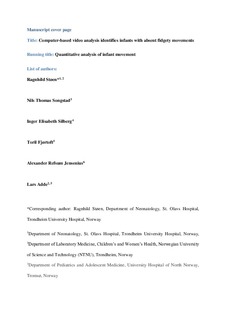Computer-based video analysis identifies infants with absence of fidgety movements
Støen, Ragnhild; Songstad, Nils Thomas; Silberg, Inger Elisabeth; Fjørtoft, Toril Synnøve Larsso; Jensenius, Alexander Refsum; Adde, Lars
Journal article, Peer reviewed
Submitted version
Permanent lenke
http://hdl.handle.net/11250/2482660Utgivelsesdato
2017Metadata
Vis full innførselSamlinger
Sammendrag
Background: Absence of fidgety movements (FMs) at 3 months’ corrected age is a strong predictor of cerebral palsy (CP) in high-risk infants. This study evaluates the association between computer-based video analysis and the temporal organization of FMs assessed with the General Movement Assessment (GMA). Methods: Infants were eligible for this prospective cohort study if referred to a high-risk follow-up program in a participating hospital. Video recordings taken at 10–15 weeks post term age were used for GMA and computer-based analysis. The variation of the spatial center of motion, derived from differences between subsequent video frames, was used for quantitative analysis. Results: Of 241 recordings from 150 infants, 48 (24.1%) were classified with absence of FMs or sporadic FMs using the GMA. The variation of the spatial center of motion (CSD) during a recording was significantly lower in infants with normal (0.320; 95% confidence interval (CI) 0.309, 0.330) vs. absence of or sporadic (0.380; 95% CI 0.361, 0.398) FMs (P<0.001). A triage model with CSD thresholds chosen for sensitivity of 90% and specificity of 80% gave a 40% referral rate for GMA. Conclusion: Quantitative video analysis during the FMs’ period can be used to triage infants at high risk of CP to early intervention or observational GMA.
